Centauri Dreams
Imagining and Planning Interstellar Exploration
Claudio Maccone (1948-2025)
In all too many ways, I wasn’t really surprised to learn that Claudio Maccone had passed away. I had heard the physicist and mathematician had been in ill health, and because he was a poor correspondent in even the best of times, I was left to more or less assume the worst. His death, though, seems to have been the result of an accident (I’m reminded of the fall that took Freeman Dyson’s life). Claudio and I spent many hours together, mostly at various conferences, where we would have lengthy meals discussing his recent work.

Image: I took this photo of Claudio in Austin, TX in 2009. More on that gathering below.
With degrees in both physics and mathematics from the University of Turin, Claudio received his PhD at King’s College London in 1980. His work on spacecraft design began in 1985, when he joined the Space Systems Group of Alenia Spazio, now Thales Alenia Space Italia, which is where he began to develop ideas ranging from scientific uses for the lunar farside, SETI detections and signal processing, space missions involving sail concepts and, most significantly, a mission to the solar gravitational lens, which is how he and I first connected in 2003.

Coming into the community of deep space scientists as an outsider, a writer whose academic expertise was in far different subjects, I always appreciated the help I received early on from people who were exploring how we might overcome the vast distances between the stars. I had written about Claudio’s ideas on gravitational lensing and the kind of mission that might use it for observation of exoplanets, but was startled to find him waiting at breakfast one morning in Princeton, where Greg Matloff had invited me up for a conference.
Image: At one of the Breakthrough Starshot meetings not long after the project was announced. I took this in the lobby of our hotel in Palo Alto.
Ever the gentleman, Claudio wanted to thank me for my discussion of his work in my Centauri Dreams book, and that breakfast with Greg, his wife C, and Claudio remains a bright memory. As is the conference, chaired by Ed Belbruno, where I made many contacts talking to scientists about their work. I was already writing this site, which began in 2004, and over the years that followed, I would run into Claudio again and again, and not always at major conferences. He appeared, for example, at a founding session of what would grow into the Interstellar Research Group in Oak Ridge, quite a hike from Italy, but when it came to interstellar ideas, Claudio always wanted to be there.

One memorable trip was at Aosta in the Italian Alps, a meeting I particularly cherish because of our meals discussing local history as much as spaceflight. Several of the participants at the Aosta conference had brought their families, and one young boy was fascinated with something Claudio said one night at dinner about Italian history. I’ll never forget his asking Claudio if he could explain what had happened in the Thirty Years War. Claudio didn’t miss a beat. He began talking and in about fifteen minutes had laid out the causes of the conflict between Protestants and Catholics in 17th Century Europe within the context of the Holy Roman Empire, complete with names, dates and details.
I asked him afterwards if he had ever considered a career in history, and it turned out that we both shared an interest especially in Greek and Latin, and that yes, the subject appealed to him, whether it was 17th Century political evolution or the fine points of Pericles’ Funeral Oration. But here he voiced a caution. “You can’t do everything. You just can’t. You have to give so many things up to do your work.” True, of course, and yet somehow his knowledge was that of a polymath. He schooled me on Leibniz over wine and Beef Wellington one night in Dallas, a conversation that went on until late in the evening. In the Italian Alps, he took me into the history of Anselm of Canterbury, who had been born in Aosta, and explained the significance of his philosophy.
Mostly, of course, we talked about space. His fascination with SETI was obvious, and his work on the mathematics of first contact brought the Kosambi–Karhunen–Loève (KLT) theorem into play as a signal processing solution. His work on gravitational lensing and the mission he called FOCAL put that concept in the spotlight, paving the way for later approaches that could solve some of the problems he had identified. A look through the archives here will reveal dozens of articles I’ve written on this and other aspects of his work.
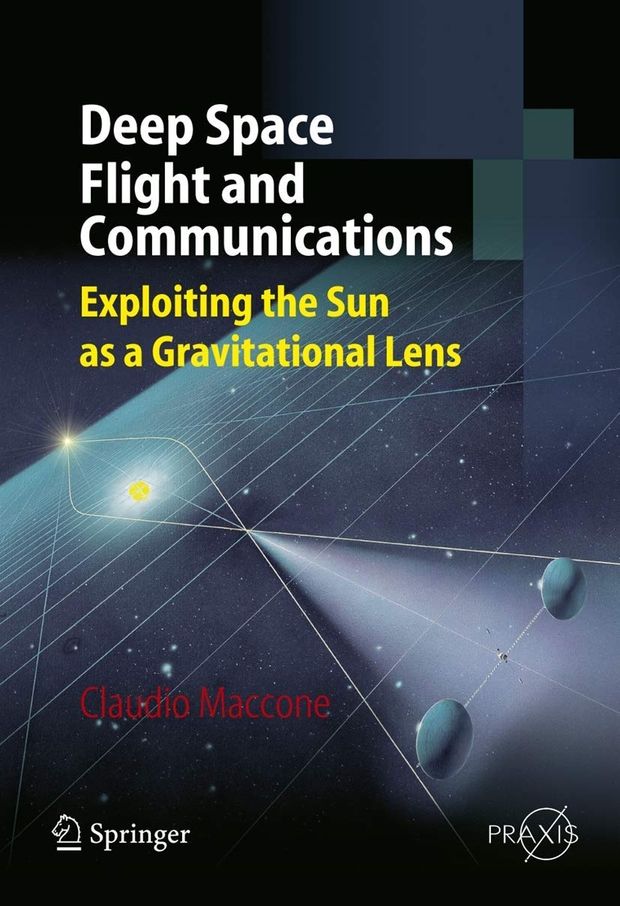
Version 1.0.0
I won’t go into the technical details here – this is a time for recollection more than analysis. But I need to mention that Claudio served as Technical Director for Scientific Space Exploration at the International Academy of Astronautics, a post of which he was rightly proud. Over 100 scientific papers bear his name, as do a number of books, the most influential being Mathematical SETI (2012) and Deep Space Flight and Communications (2009). His ongoing efforts to preserve the lunar farside for astronomical observations remind us of how precious this resource should be in our thinking. Toward the end of his life, he put his mathematical skills to work on the evolution of cultures on Earth and asked whether what he called Evo-SETI could be developed as a way to predict the likelihood of civilizations including our own surviving.
Claudio’s death caused a ripple of comment from people who had worked with him over the years. Greg Matloff, a close friend and colleague, wrote this:
I met Claudio during a Milan solar sail symposium in 1990. We collaborated for years on sails to the solar gravity focus. He was instrumental in my guest professorship in Siena in summer 1994 and my election to IAA. I knew that his health had become a challenge. Apparently, a book shelf had collapsed and he was pinned overnight until his student found him the following morning. I will miss Claudio forever but am glad that I saw him in Luxembourg last December.
I only wish I could have seen Claudio one more time, but it was not to be. I will always honor this good man and thank him for his generosity of spirit, his engaging humor and his willingness to bring me up to speed on concepts that, early on, I found quite a stretch. Now that the concept of a gravitational lensing mission is widespread in the literature and superb work continues at the Jet Propulsion Laboratory on completely new technologies to make this happen, I think Claudio’s place in the history of the interstellar idea is guaranteed.
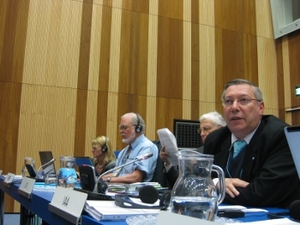
Image: Claudio Maccone speaking before the United Nations Committee on the Peaceful Uses of Outer Space in Vienna 2010. He was proposing a radio-quiet zone on the farside that will guarantee radio astronomy and SETI a defined area in which human radio interference is impossible. It’s an idea with a pedigree, going back to 1994, when the French radio astronomer Jean Heidmann first proposed a SETI observatory in the farside Saha Crater with a link to the nearside Mare Smythii plain and thence to Earth. Credit: COPUOS.
A final happy memory. Claudio and I had met in Austin Texas and were headed to the Institute for Advanced Studies Austin, to meet with Marc Millis, Eric Davis and Hal Puthoff, among others. Claudio had just bought a new laptop so powerful that it could handle the kind of equations he threw at it. On the way, he bragged about it and showed it to me with delight all over his face.
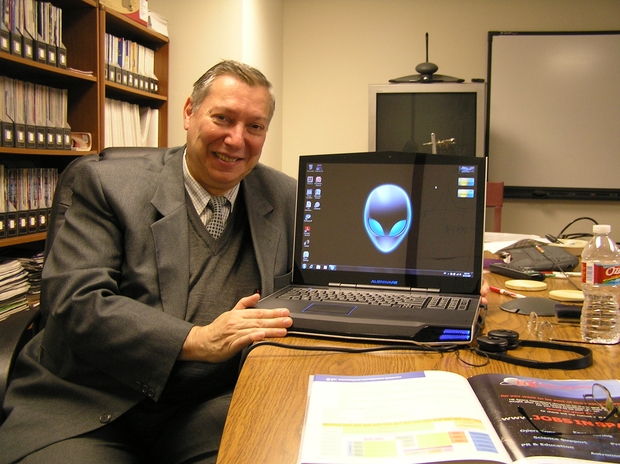
But the joke was that with facial recognition, it refused to recognize him despite his protracted training of the gadget. I can still hear his normally calm voice gradually growing in volume (the meeting had already started and everyone was taking notes), until finally he burst out with “It’s me, damn you!” We all guffawed, and a few seconds later, amazingly, the computer let him in.
Claudio loved Latin, so here’s a bit from Seneca:
Non est ad astra mollis e terris via.
Which means “There is no easy way from the earth to the stars.”
He certainly would have agreed with that statement, but Claudio Maccone did everything in his power to tackle the problem and show us the possibilities that lay beyond our current technologies. His work was truly a gift to our future.

Generation Ships and their Consequences

Our ongoing discussion of the Project Hyperion generation ship contest continues to spark a wide range of ideas. For my part, the interest in this concept is deeply rooted, as Brian Aldiss’ Non-Stop (1958 in Britain, and then 1959 in the U.S. under the title Starship), was an early foray into science fiction at the novel length for me. Before that, I had been reading the science fiction magazines, mostly short stories with the occasional serial, and I can remember being captivated by the cover of a Starship paperback in a Chicago bookstore’s science fiction section.
Of course, what was striking about Criterion Books’ re-naming of the novel is that it immediately gave away the central idea, which readers would otherwise have had to piece together as they absorbed Aldiss’ plot twists. Yes, this was a starship, and indeed a craft where entire generations would play out their lives. Alex Tolley and I were kicking the Chrysalis concept around and I was reminded how, having been raised in Britain, Alex had been surprised to learn of the American renaming of the book. But in a recent email, he reminded me of something else, and I’ll pass that along to further seed the discussion.
What follows is from Alex, with an occasional interjection by me. I’ll label my contributions and set them in italics to avoid confusion. Alex begins:
I should mention that in Aldiss’ novel Non-Stop, the twist was that the starship was no longer in transit, but was in Earth’s orbit. The crew could not be removed from the ship as it slowly degenerated. The Earthers were the ‘giants’ visiting the ship to monitor it and study the occupants.
PG: Exactly so. To recapitulate, the starship had traveled to a planet around Procyon, and in a previous generation had experienced a pandemic evidently caused by human incompatibility with the amino acids found in its water. On the return trip, order breaks down and the crew loses knowledge of their circumstances, although we learn that there are other beings who sometimes appear and interact in mysterious ways with the crew. The twenty-three generations that have passed are far more than was needed to reach their destination, but now, in Earth orbit, their mutated biology causes scrutiny from scientists who restrict their movement while continuing to study them.
PG: The generation ship always raises questions like this, not to mention creating questions about the ethics of controlling populations for the good of the whole. I commented to Alex about the Chrysalis plan to have multiple generations of prospective crew members live in Antarctica to ensure their suitability for an interstellar voyage and its myriad social and ethical demands. He mentions J.G. Ballard’s story “Thirteen to Centaurus” below, a short story discussed at some length in these pages by Christopher Phoenix in 2016.

Image: The original appearance of “Thirteen to Centaurus,” in The July, 1962 issue of Amazing Fact and Science Fiction Stories. Rather than having to scan this out of my collection, I’m thankful to the Classics of Science Fiction site for having done the scanning for me.
I missed the multiple generations in Antarctica bit, probably because I knew the UK placed Antarctic hopefuls in a similar environment for at least several weeks to evaluate suitability. The 500-day Martian voyage simulation would be like a prison sentence for the very motivated. But several generations in some enclosed environment would perhaps be like the simulated starship in “Thirteen to Centaurus” or the 2014 US TV series Ascension. Note that Antarctica is just a way of suggesting an isolated environment, which the authors indicate is TBD. Like the 500-day Mars simulation, all the authors want is a way to test for psychological suitability.
To do this over a span of multiple generations seems very unethical, to say the least. How are they going to weed out the “unsuitable”, especially after the first generation? I also think that there is a flaw in the reasoning. Genetics is not deterministic, especially as the authors expect normal human partnering on the ship. The sexual reproduction of the genes will constantly create genetically different children. This implies that the nurture component of socialization will be very important. How will that be maintained in the simulation, let alone the starship? Will the simulation inhabitants have to resolve all problems and any anti-social behavior by themselves? What if it becomes a “Lord of the Flies” situation? Is the simulation ended and a new one started when a breakdown occurs? It is a pity that the starship cannot be composed of an isolated tribe that has presumably already managed to maintain multi-generational stability.
If we’re going to simulate an interstellar voyage, we could build the starship, park it in an orbit within the solar system, and monitor it for the needed time. This would test everything for reliability and stability, yet ensure that the population could be rescued if it all goes pear-shaped. The ethics are still an issue, but if the accommodation is very attractive, it is perhaps not too different from living on a small island in the early industrial period, isolated from the world. The Hebrides until the mid-20th century might be an example, although the adventurous could leave, which is not a possibility on the starship.
Ethics aside, I suspect that the Antarctica idea is more hopeful than viable. In my view, it will take a very different kind of society to maintain a 100+ year simulation. But there are advantages to doing this in Earth orbit. It could be that the crew becomes a separate basket of eggs to repopulate the Earth after a devastating war, as Moon or Mars colonies are sometimes depicted.
PG: I’ve always thought that rather than building a generation ship, such vessels would evolve naturally. As we learn how to exploit the resources of the Solar System, we’ll surely become adept at creating large habitats for scientists and workers. A natural progression would be for some crew, no longer particularly interested in living on a planet, to ‘cast off’ and set off on a generational journey.
Slow boating to star systems will probably require something larger, more like an O’Neill Island 3 design. Such colonies will be mature, and the remaining issue of propulsion “solved” by strapping on whatever is the most appropriate – fusion, antimatter, etc. The ethics problem is presumably moot in such colonies, as long as the colony votes to leave the solar system, and anyone preferring to stay is allowed to leave.
This is certainly what Heppenheimer and O’Leary were advocating when the space colony idea was new and shiny. On the other hand, maybe the energy is best used to propel a much smaller ship at high fractional c to achieve time dilation. If it fails, only the first-generation explorer crew dies. In extremis, this is Anderson’s Tau Zero situation.
PG: With your background in biology, Alex, what’s your take on food production in a generation ship? I realize that we have to get past the huge question of closed loop life support first, but if we do manage that, what is the most efficient way to produce the food the crew will need?
I think that by the time a Chrysalis ship can be built, they won’t be farming field crops as we do today. The time allocated to agricultural activities might be better spent on some other activity. Food production will be whatever passes for vertical farms and food factory culture, with 3-D printing of foods for variety.
The only value I can see for traditional crop farming is that it may be the only way to expand the population on the destination planet, and that means maintaining basic farming skills. The Chrysalis design did not allow animal husbandry, which means that the crew would be Vegan or Vegetarian only. In that future, that may even be the norm, and eating animal flesh a repellant idea.
In any case, space colonies should be the first to develop the technology for very long-duration missions, then generation starships if that is the only way to reach the stars, and assuming it is deemed a worthwhile idea. That techbro, Peter Thiel, cannot get seasteading going. I do wonder whether human crewed starships for colonization make much sense.
But multi-year exploration ships evoking the golden age of exploration in sailing ships might be a viable idea. Exciting opportunities to travel, discover new worlds (“new life, and new civilizations…”), yet returning to the solar system after the tour is over. It would need fast ships or some sort of suspended animation to reduce the subjective time during the long cruise phase, so that most of the subjective time would be the exploration of each world.
PG: I’ll add to that the idea that crews on generation-class ships and their counterparts on this kind of faster mission may well represent the beginning of an evolutionary fork in our species. Plenty of interesting science fiction to be written playing with the idea that there is a segment of any population that would prefer to experience life within a huge, living habitat, and thus eventually become untethered to planting colonies or exploiting a planetary surface for anything more than scientific data-gathering.
Like the university-crewed, habitat-based starship in Vonda McIntyre’s Starfarers tetralogy. The ship is based on O’Neill’s space colony technology, but it can travel at FTL velocities and is mostly about exploring new worlds. It is very Star Trek in vibes, but more exploratory, fewer phasers and photon torpedoes.
PG: So the wave of outward expansion could consist of the fast ships Alex mentions followed by a much slower and different kind of expansion through ships like Chrysalis. I’ll bring this exchange to a close here, but we’ll keep pondering interstellar expansion in coming months, including the elephant-in-the-room question Alex mentioned above. Will we come to assume that crewed starships are a worthwhile idea? Is the future outbound population most likely to consist of machine intelligence?

Chrysalis: Designing a Generation Ship
If you want to explore the history of generation ships in science fiction, you might start with a story by Don Wilcox. Writing in 1940 for Amazing Stories, Wilcox conceived a slick plot device in his “The Voyage that Lasted 600 Years,” a single individual who comes out of hibernation once every century to see how the rest of the initial crew of 33 is handling their job of keeping the species going. Only room for one hibernation chamber, and this means our man becomes a window into social change aboard the craft. The breakdown he witnesses forces him into drastic action to save the mission.
In a plot twist that anticipates A. E. van Vogt’s far superior “Far Centaurus,” Wilcox has his ragged band finally arrive after many generations at destination, only to find that a faster technology has long ago planted a colony there. Granted, Konstantin Tsiolkovsky had written about generation ships before Wilcox, and in a far more learned way. Fictional precedents like Laurence Manning’s “The Living Galaxy” (Wonder Stories, 1934) and Olaf Stapledon’s Star Maker (1937) imagined entire worlds as stellar wanderers, but we can give Wilcox a nod for getting the concept of generations living and dying aboard a constructed craft in front of the public. Heinlein’s “Universe” wouldn’t appear until 1941, and the generation ship was soon to become a science fiction trope.

We can hope that recent winners of the generation ship contest for Project Hyperion have produced designs that avoid the decadence and forgetfulness that accompany so many SF depictions. We do, after all, want a crew to reach destination aware of their history and eager to add to the store of human knowledge. And we have some good people working these issues, scientists such as Andreas Hein, who has been plucky enough to have led Project Hyperion since 2011. Working with the Initiative for Interstellar Studies, Hyperion has announced a contest winner that leverages current technologies and speculates in the best science fiction tradition about how they can be extended.

Hein is an energetic visionary, a man who understands that imaginative forays can help us define key issues and sketch out solutions. The winning design is reminiscent of the kind of space habitats Gerard O’Neill advocated, a 58-kilometer multi-layered cylinder dubbed Chrysalis that offers space enough for Earth-like amenities such as grasslands and parks, art galleries and libraries. The notion includes animals, though only as a token of biodiversity in a culinary scene where vegetarianism is the order of the day.
Interstellar Necessities
What intrigues me about the Chrysalis design is that the need for cultural as well as physical survival in a society utterly closed off for centuries is emphasized. Thus Chrysalis offers habitable conditions for 1,000 people plus or minus 500, with care to ensure the handing off of experience and knowledge to future generations, critical both for societal health as well as the maintenance of the ship’s own technologies. This presumes, after all, the kind of closed-loop life support we have yet to prove we can create here on Earth (more on that in a minute). Gravity is provided through rotation of the craft.
Chrysalis is designed around a journey to Proxima Centauri, with the goal of entering into orbit around Proxima b in some 400 years. And here we hit an immediate caveat. Absent any practical means of propelling something of this magnitude to another star at present (much less of building it in the first place), the generation ship designers have no choice but to fall back on extrapolation. As in the tradition of hard science fiction, the idea is to stick rigorously within the realm of known physics while speculating on technologies that could one day prove feasible. This is not intended as a criticism; it’s just a reminder of how speculative the Chrysalis design is given that I keep seeing that 400 year figure mentioned in press coverage of the contest. We might well have said 600. Or 4,000. Or 40,000.
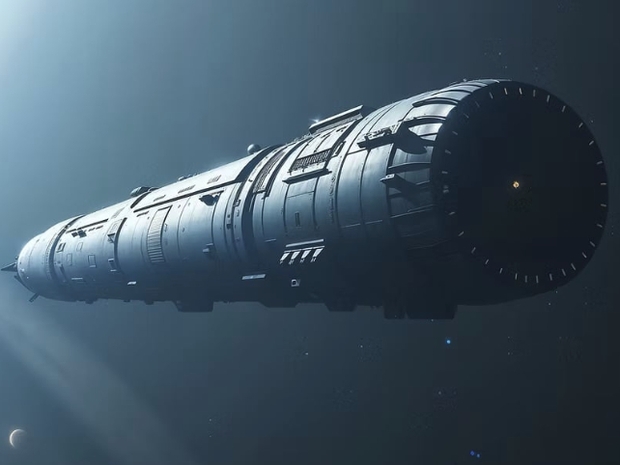
Image: Chrysalis, the Project Hyperion winner. Credit: Project Hyperion/i4IS.
Like the British Interplanetary Society’s Daedalus starship, Chrysalis is envisioned as using deuterium and helium-3 to power up its fusion engines, with onboard power also fed by fusion generators within the ship. The goal is 0.01C with 0.1G acceleration during the acceleration phase and deceleration phase. As to cruise, we learn this about the fusion power sources that will prove crucial:
All Chrysalis power generators consist of toroidal nuclear fusion reactors housed in the hull frame structure and the habitat axial frame structure separating the various stages. The multiple redundancy of the generators for each shell and each stage guarantees a high tolerance to failure in the event of the failure of one or more reactors. The D and He3 liquid propellant is contained in the propellant tank units located in the forward and after interface propellant bays of the habitat module…
Inside Chrysalis
What would it be like to live aboard a generation starship? The Chrysalis report is stuffed with images and ideas. I like the concept of structures designed around capturing what the team calls ‘generational memories.’ These appear to be tall, massive cylinders designed around what can only be called the aesthetics of worldship travel. Thus:
Each treelike structure hosts multi-story and multi-purpose environments [such] as halls, meeting rooms, and other kinds of infrastructure used by all the inhabitants as collective spaces. There are enough of these public environments to have redundant spaces and also to allow each generation to leave a mark on creation (paintings, sculptures, decorations, etc) for future generations…
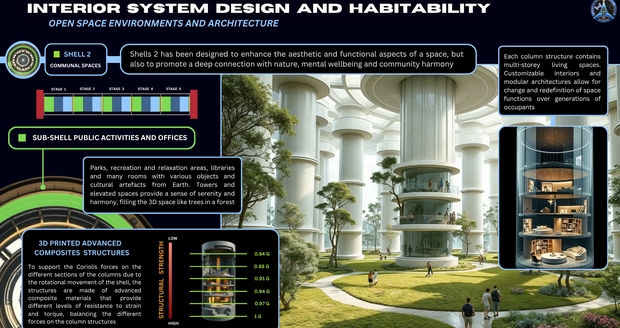
The Chrysalis slide show makes it tricky to capture the extensive interior design in a blog format like this, but I advocate paging through it so you can blow the imagery up for a closer look at the included text. As with some of the O’Neill concepts, there is an almost idyllic feel to some of these vistas. Chrysalis is divided into five sections, and within each section there are levels that rotate to provide artificial gravity. The report refers to Chrysalis as a ‘biome ark,’ saying that within each stage there are two shells for dedicated biomes and one for agricultural food production.
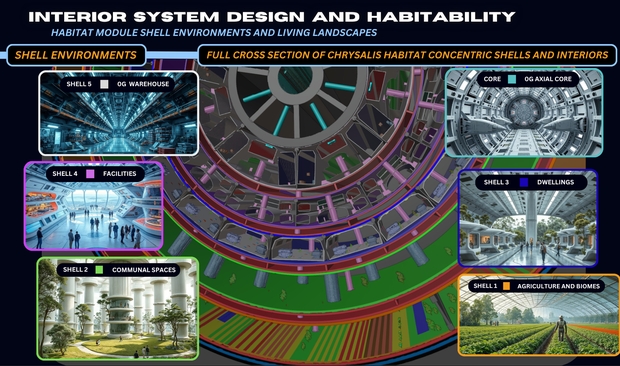
Here, of course, we run into a key problem (and readers of Kim Stanley Robinson’s novel Aurora (2015) certainly get a taste of this conundrum). Let me quote the Chrysalis report, which describes ‘controlled ecological bio-regenerative life support systems (CEBLSS)’:
Through a controlled ecological BLSS all chemicals are recycled and reused in a closed loop ecosystem together with a circular bio-economy system in which all organic wastes from the living environments are reintroduced and composted in the agricultural soils.
The acronym nudges the idea into credibility, for we tend to use acronyms on things we’ve pinned down and specified. But the fact is that closed-loop life support is as big a problem as propulsion when it comes to crafting a ship made to sustain human beings for perhaps thousands of years. The Soviet BIOS-1 and subsequent BIOS projects made extensive experiments with human crews, succeeding with full closure for up to 180 days in one run at Krasnoyarsk, while in the U.S., Biosphere 2 ran into serious problems in CO2 and food production. As far as I know, the Chinese Yuegong-1 experiments produced a solid year of closed ecological life support, although I haven’t been able to verify whether this system was 100 percent closed.
Daily Life Between the Stars
So I think we’re making progress, and the Chrysalis report certainly lays out how we might put closed-loop life support to work on the millennial scale. But all this does make me reflect on the fact that we’ve spent most of our energies in interstellar studies trying to work out propulsion, when we’re still in the early days when it comes to onboard ecologies, no matter how beautifully designed. In the same way, we know how to get a payload to Mars, but how to get a healthy crew to the Red Planet and back is still opaque. We need a dedicated orbital facility studying both near and long-term human physiology in space.
The Chrysalis living spaces are made to order as science fiction settings. Interior walls can be functional screens producing panoramic views from Earth environments to overcome the spatial (and psychiatric) limitations of the craft. The inhabitants are given the capability of continually engineering their own living spaces through customizable 3D printing technologies so that the starship itself can be seen as evolving as the crew generations play out their lives. Individuals are provided with parks and gardens to enhance privacy, no small consideration in such a ship. The authors’ slide show goes into considerable detail on ecology and sustainability, social organization and mental health.
In a lovely touch, the team envisions a ‘Cosmos Dome,’ a giant glassy structure where the plenary council for the mission would transact its business. One gets a goose bump or two here, reminiscent as all this is of, say, the control room in Heinlein’s Orphans of the Sky. Burst in there and you suddenly are reminded of just where you are, with Sol behind and Alpha Centauri ahead.
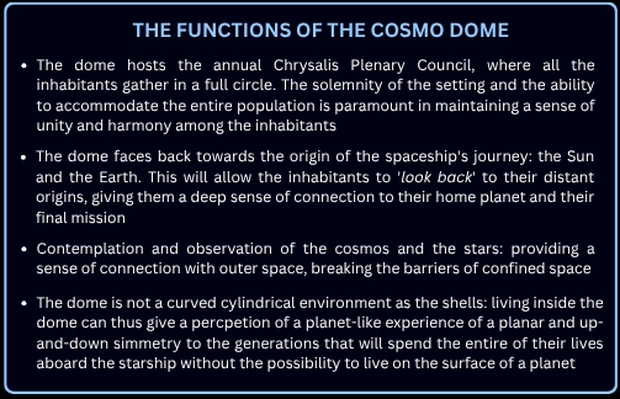
How exactly to select and train a crew, or maybe I should say ‘initial passenger list,’ for such a mission? The Hyperion team’s forays into sociology are curious and almost seem totalitarian. Consider their Antarctic strategy: Three or four generations of crew will live in experimental biospheres in Antarctica…
…to select and monitor all the characteristics that an interstellar population should have. In addition, the creation of a strong group identity and an almost tribal sense of cooperation among the generations of inhabitants is intended to enhance the inter-generational cooperative attitude of the future Chrysalis starship population.
If I’m reading this correctly, it presupposes people who are willing to consign their entire lives to living in Antarctica so that their descendants several generations along can get a berth on Chrysalis. That’s a pretty tough sell, but it emphasizes how critical the suppression of conflict in a tiny population can be. I’m reminded of John Brunner’s “Lungfish,” which ran in the British SF magazine Science Fantasy in 1957 (thanks to Elizabeth Stanway, whose “Journey of (more than) a Lifetime” covers generation ship fictional history well). Here the descendants have no interest at all in life on a planet. As Brunner says:
These had been children like any other children: noisy, inquisitive, foolhardy, disobedient…. And yet they had grown up into these frighteningly self-reliant people who could run the ship better than the earthborn any time they put their minds to it, and still refused to take the initiative.
Definitely an outcome to be avoided!
Language and Stability
The Chrysalis team describes their crew’s mental stability as being enhanced by many reminders of their home:
Chrysalings will also be able to take walks within the different terrestrial biomes of Shell 1 to be in contact with natural elements and plants of the terrestrial biosphere. In Shell 2 there will be opportunities to do concerts, experience theater activities, access ancient Earth materials (books, art objects, etc.), make crafts and other handmade hobby activities. Shell 2 is the real beating heart of the society, where people come together and can freely co-create new cultures and ideas. Thanks to the use of recyclable materials with which the buildings were constructed, residents can also decide to recreate new architectural forms with different shapes and spaces more suitable to their cultural style.
I think the linguistic notion here is quite a reach, for the team says that to avoid language problems, everyone on board the spacecraft will speak a common initial artificial language “used and improved by the Antarctic generations in order to render it a natural language.” And a nod to Star Trek’s holodeck:
The inhabitants may also occasionally decide to meet in simulated metaverses through a deep integration system for cyberspace…to transcend the physical barriers of the starship and experience through their own twin-avatar new worlds or simulations of life on Earth.

Image: The people behind Chrysalis. Left to right: Giacomo Infelise (architect/designer), Veronica Magli (economist/social innovator), Guido Sbrogio (astrophysicist), Nevenka Martinello (environmental engineer/artist), Federica Chiara Serpe (psychologist). Team Chrysalis.
Anyone developing a science fiction story involving generation ships will want to work through the Chrysalis slide show, as the authors leave few aspects of such a journey untouched. I’ve simply been cherry-picking items that caught my eye out of this extensively developed presentation. If we ever become capable of sending humans and not just instruments to nearby stars, we’ll have to have goals and aspirations firmly fixed, and compelling reasons for sending out an expedition that will have no chance of ever returning. Just defining those issues alone is subject for investigations scientific, medical, biological and philosophical, not to mention the intricate social issues that humans pose in closed environments. Chrysalis pushes the discussion into high relief. Nice work!

A Candidate Gas Giant at Alpha Centauri A
Early next week I’ll be discussing the winning entry in Project Hyperion’s design contest to build a generation ship. But I want to sneak in the just announced planet candidate at Alpha Centauri A today, a good fit with the Hyperion work given that the winning entry at Hyperion is designed around a crewed expedition to nearby Proxima Centauri. Any news we get about this triple star system rises immediately to the top, given that it’s almost certainly going to be the first destination to which we dispatch instrumented unmanned probes.
And one day, perhaps, manned ships, if designs like Hyperion’s ‘Chrysalis’ come to fruition. More on that soon, but for today, be aware that the James Webb Space Telescope is now giving us evidence for a gas giant orbiting Centauri A, the G-class star intriguingly similar to the Sun, which is part of the close binary that includes Centauri B, both orbited by the far more distant Proxima.
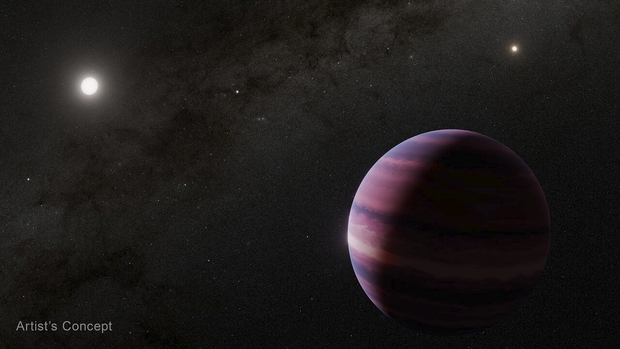
Image: This artist’s concept shows what the gas giant orbiting Alpha Centauri A could look like. Observations of the triple star system Alpha Centauri using the NASA/ESA/CSA James Webb Space Telescope indicate the potential gas giant, about the mass of Saturn, orbiting the star by about two times the distance between the Sun and Earth. In this concept, Alpha Centauri A is depicted at the upper left of the planet, while the other Sun-like star in the system, Alpha Centauri B, is at the upper right. Our Sun is shown as a small dot of light between those two stars. Credit: NASA, ESA, CSA, STScI, R. Hurt (Caltech/IPAC).
JWST’s Mid-Infrared Instrument (MIRI) once again proves its worth, as revealed in two papers in process at The Astrophysical Journal Letters. If this can be confirmed as a planet, its orbit appears to be eccentric (e ≈ 0.4) and significantly inclined with respect to the orbital plane of Centauri A and B. But we have a lot of work ahead to turn this candidate, considered ‘robust’ by the team working on it, into a solid detection.
The proximity of the central binary stars at Alpha Centauri makes this kind of work extremely difficult, one reason why a system so close to our own is only gradually revealing its secrets. Bear in mind that MIRI was able to subtract the light from both stars to reveal an object 10,00 times fainter than Centauri A. The Webb instrument took observations beginning in August of 2024 that posed a subsequent problem, for two additional observation periods in the spring of this year failed to find the object. Interestingly, computer simulations have clarified what may have happened, according to PhD student Aniket Sanghi (Caltech), co-first author of one of the two papers describing this work:
“We are faced with the case of a disappearing planet! To investigate this mystery, we used computer models to simulate millions of potential orbits, incorporating the knowledge gained when we saw the planet, as well as when we did not,.. We found that in half of the possible orbits simulated, the planet moved too close to the star and wouldn’t have been visible to Webb in both February and April 2025.”
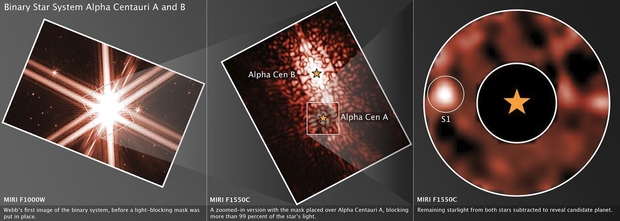
Image: This 3-panel image captures the NASA/ESA/CSA James Webb Space Telescope’s observational search for a planet around the nearest Sun-like star, Alpha Centauri A. The initial image shows the bright glare of Alpha Centauri A and Alpha Centauri B, then the middle panel shows the system with a coronagraphic mask placed over Alpha Centauri A to block its bright glare. However, the way the light bends around the edges of the coronagraph creates ripples of light in the surrounding space. The telescope’s optics (its mirrors and support structures) cause some light to interfere with itself, producing circular and spoke-like patterns. These complex light patterns, along with light from the nearby Alpha Centauri B, make it incredibly difficult to spot faint planets. In the panel at the right, astronomers have subtracted the known patterns (using reference images and algorithms) to clean up the image and reveal faint sources like the candidate planet. Credit: NASA, ESA, CSA, STScI, DSS, A. Sanghi (Caltech), C. Beichman (JPL), D. Mawet (Caltech), J. DePasquale (STScI).
The combination of observations and orbital simulations indicates that a gas giant of about Saturn mass moving in an elliptical orbit within Centauri A’s habitable zone remains a viable option. Also fed into the mix were the parameters of a 2019 observation of Centauri A and B from the European Southern Observatory’s Very Large Telescope. It is clear that the point source referred to as S1 is not a background object like a galaxy or a foreground asteroid moving between JWST and the star. Its orbital parameters would make it quite interesting given the tight separation between Centauri A and B.
The second of the two papers clarifies the significance of such a find and the need to confirm it. The temperature calculated below is based on the photometry and orbital properties of the candidate object, with 200–350 K originally expected for a planet heated by Centauri A at 1.3 AU:
A confirmation of the S1 candidate as a gas giant planet orbiting our closest solar-type star,α Cen A, would present an exciting new opportunity for exoplanet research. Such an object would be the nearest (1.33 pc), coldest (∼225 K), oldest (∼5 Gyr), shortest period (∼2–3 years), and lowest mass (≲ 200 M⊕) planet imaged in orbit around a solar-type star, to date. Its extremely cold temperature would make it more analogous to our own gas giant planets and an important target for atmospheric characterization studies. Its very existence would challenge our understanding of the formation and subsequent dynamical evolution of planets in complex hierarchical systems. Future observations will confirm or reject its existence and then refine its mass and orbital properties, while multi-filter photometric and, eventually, spectroscopic observations will probe its physical nature.
The papers are Beichman et al., “Worlds Next Door: A Candidate Giant Planet Imaged in the Habitable Zone of α Cen A. I. Observations, Orbital and Physical Properties, and Exozodi Upper Limits,” accepted at Astrophysical Journal Letters (preprint); and Sanghi, et al., “Worlds Next Door: A Candidate Giant Planet Imaged in the Habitable Zone of α Cen A. II. Binary Star Modeling, Planet and Exozodi Search, and Sensitivity Analysis,” accepted at ApJL (preprint). The paper on the 2019 observation is Wagner at al., “Imaging low-mass planets within the habitable zone of α Centauri,” Nature Communications 10 February 2021 (full text).

A Rotating Probe Launcher Alternative to TARS
Shortly before publishing my article on David Kipping’s TARS concept (Torqued Accelerator using Radiation from the Sun), I received an email from Centauri Dreams associate editor Alex Tolley. Alex had come across TARS and offered his thoughts on how to improve the concept for greater efficiency. The publication of my original piece has launched a number of comments that have also probed some of these areas, so I want to go ahead and present Alex’s original post, which was written before my essay got into print. All told, I’m pleased to see the continuing contribution of the community at taking an idea apart and pondering alternative solutions. It’s the kind of thing that gives me confidence that the interstellar effort is robust and continuing.
by Alex Tolley
Dr. Kipping’s TARS proposed system for accelerating probes to high velocity is both simple and elegant. With no moving parts other than any tether deployment and probe release, if it works, there is little that can fail during the spin-up period. There are improvements to the basic idea that increase performance, although this essay will suggest a more complex, but possibly more flexible and performant approach using the basic rotating tether concept.
First, a small design change of TARS to increase the rate of spin-up. The TARS design is like a Crookes radiometer, but working in reverse, with the mirror face of the sail experiencing a greater force than the obverse dark, emissive face. As the tethers rotate, the reflective face increases the spin rate, whilst the emissive face swinging back towards the sun acts as a retarding force. An easy improvement, at the cost of a moving part, is to have the sail reorient itself to be edge-on to the sun as it returns. This is illustrated in Figure 1 below. The rotation can be any mechanism that sequentially rotates the sail by 90 degrees after the tether is aligned with the sun, or other electromagnetic radiation source.

Figure 1. The simplified TARS system with the sail rotating around the tether to reduce the retarding force in the rotation phase.
There are other possibilities to tweak the performance, but at a cost of complexity and added mass.
However, I want to offer an alternative approach that solves some of the limitations of the proposed TARS system.
These limitations include:
- The propulsive force is very phase-dependent as the tether rotates.
- The rotation rate is dependent on the sail aerial density and size<
- The sails add mass to the tether and therefore increase the tether tension, requiring an increased taper
- The TARS rotation must be aligned with the radiation source, limiting the direction it can throw the payloads. This means that a target on an inclined plane to the planets, such as a comet or exoplanet, requires the TARS to take on an inclined orbit, limiting its flexibility.
- The asymmetric forces on TARS change its orbit.
These limitations can be alleviated by eliminating the sails and replacing the rotation with an electric motor, powered by a solar panel. The basic design is shown in Figure 2.

Figure 2. Basic design of a rotating probe launcher using motor-driven tethers.
The tether is powered by an electric motor that requires a counter-rotating wheel or tether (see later) to prevent the system from rotating. This is similar to the power equipment astronauts use in space. The tether is attached to the solar panel by a 3-axis joint to allow full control of the rotational plane of the tether. As the only loads on the tether are its own mass and the releasable probes, the amount of taper should be less than TARS, allowing longer tethers of the same material. The tethers can be flexible or stiff, depending on deployment preferences. Figure 2 shows a preferred arrangement where the tethers form a square, with cable stays to increase rigidity and offset bending during spin-up.
The tether would have 2 releasable probes and 2 small ballasts to maintain tension, or 4 probes. The probes can be released simultaneously in opposite directions, or in the same direction from 1-10 milliseconds apart, depending on the rotation rate. If released in the same direction, the system will tend to be pushed in the opposite direction as the probes released in the same direction would act as propellant, generating thrust in the opposite direction.
A variant would allow for 2 contra-rotating tethers. Because they are mechanically coupled to the same motor, this guarantees that they rotate in synchrony and eliminate the gyroscopic action of a single tether. This removes the need for a counter-rotating disc for the motor, but more importantly, for multiple payloads allows the rotation plane to be changed between payload releases, allowing for different target destinations for the probes to travel in. This would be ideal for a standby to target comets and objects coming from different orbital inclinations, as well as more detailed mapping of the solar system’s heliosphere.
Because the rotation is controlled by a motor, this provides more precise timing of the payload releases. Once the maximum rotation rate is reached, the motor can idle, and the system continue its orbit until the optimum probe[s] release position is achieved, for example when Mars is in opposition. This avoids the continual rotation rate increase of TARS that must release its probe[s] before the tethers snap.
So what sort of rotational speed can a motor provide? The maximum speed for a small motor is 100,000 rpm, or 1667 rps. A much lower speed is achieved by hard disk drives at 7200 rpm or 120 rps.
This translates to:

Because the rotation rate is so fast, any probe release must be timed with very high precision to ensure it travels on the correct flight path towards its destination. While not critical for some missions, encounters with small bodies such as interstellar objects (ISO) like 2I/Borisov will require very high precision releases.
Unlike TARS, the tethers can also be spun down, making the system reusable to reload the payloads. If multiple payloads can be released sequentially like a Pez dispenser, then these can be reloaded periodically when the payloads have been exhausted. With extra complexity, these cartridges of probes could be carried on the system, and attached to the tethers after the rotation has been reduced to zero, making the device relatively autonomous for long periods.
Lastly, because the rate of rotation acceleration is dependent on the motor and power available, the power can be increased with a larger solar array, and the motor torque increased with a larger motor. These are independent of the tether design, making any desired upgrades simpler, or like CubeSats, configurable on manufacture before launch.

A Space Catapult with Interstellar Potential
A new propulsion method with interstellar implications recently emerged on the arXiv site, and in an intriguing video on David Kipping’s Cool Worlds channel on YouTube. Kipping (Columbia University) has built a video production process that is second to none, but beyond the imagery is his ability to translate sophisticated mathematical concepts into clear language and engaging visuals. So while we’re going to discuss his new propulsion concept using the arXiv paper, don’t miss the video, where this novel new idea is artfully rendered.
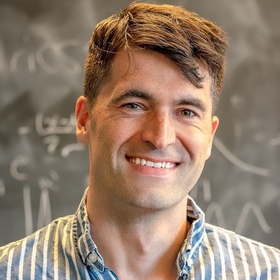
I was delighted to see the author invoking J.R.R. Tolkien in the video (though not in the paper), for he begins the Cool Worlds episode with some musings on interstellar flight and why it has come to engage so many of us. Tolkien devotees will already know the lovely term he used to explain our yearnings for something beyond ourselves: ‘sea-longing.’ It’s a kenning, to use the scholarly jargon, a metaphorical double construction that links two ideas. Anglo-Saxon poetry, about which Tolkien was a master, is rife with such turns of phrase.
Image: Columbia’s David Kipping, astrophysicist and guiding force of the Cool Worlds Lab.
Tolkien’s work on Beowulf was hugely significant to scholarship on that great poem, and The Lord of the Rings is peppered with linguistic echoes of the language. Here’s the relevant quote from The Two Towers, in which the elf Legolas invokes the things that drive his race:
And now Legolas fell silent, while the others talked, and he looked out against the sun, and as he gazed he saw white sea-birds beating up the river.
’Look!’ he cried. ‘Gulls! They are flying far inland. A wonder they are to me and a trouble to my heart. Never in all my life had I met them, until we came to Pelargir, and there I heard them crying in the air as we rode to the battle of the ships. Then I stood still, forgetting war in Middle-earth,; for their wailing voices spoke to me of the Sea. The Sea! Alas! I have not yet beheld it. But deep in the hearts of all my kindred lies the sea-longing, which it is perilous to stir. Alas! for the gulls. No peace shall I have again under beech or under elm.’
Sea-longing. If it was an innate component of Tolkien’s elvish personalities, it’s one common among all humans, I think, though clearly in greater or lesser amount depending on the person. I grew up in the American Midwest far from any ocean, but I had ‘sea-longing’ as a boy and have it still. It’s not just about oceans, of course, but about vast expanses that are partly real and partly a matter of the yearning imagination. It’s why some people have to explore.
Turning Yearning into Hardware
Kipping’s reputation is already secure as an innovator of a very high order. His work on exo-moons solidified the hunt for these objects, which surely exist but which have yet to be confirmed in the only two cases that look plausible so far. His vision of a ‘terrascope’ is reminiscent of gravitational lensing but draws on the Earth’s atmosphere to provide refractive lensing, a telescope concept that although it cannot compete with the gravity lens, nonetheless offers huge magnifications for a space-based telescope. His ‘Halo drive’ gathers energy from light boomeranging around a black hole while using no onboard fuel.
That latter idea is fully consonant with the laws of physics, but of course demands we find a way to get to a black hole to use its energies. By contrast, Torqued Accelerator using Radiation from the Sun (TARS) is a means of acceleration that could be built now. It offers no ‘warp drive’ type travel, and in fact in its most powerful iteration would weigh in at about 1000 kilometers per second. But interstellar flight pushes us to follow our leads, and we should keep in mind how huge a step 1000 km/s represents when weighed against the current defender of the velocity crown, Voyager 1 at about 17 km/s.
So let’s talk about this, because it’s a remarkable way to overcome a serious problem with solar sails, creating a way to push a payload beyond Solar System escape velocity with energy extracted from the Sun. As opposed to the Breakthrough Starshot concept, a politically impossible 100 GW laser array high in the Atacama, TARS offers us an exceedingly economical way to send not one but swarms of tiny probes. And if a journey to Proxima Centauri would take about a millennium, ask yourself what we could do with this in our own system.
The concept is blindingly simple once it’s been thought of, and like Jim Bickford’s TFINER design (see TFINER: Ramping Up Propulson via Nuclear Decay) it’s almost jarring. Why hadn’t someone thought of this before? Kipping, pondering the dilemma of interstellar propulsion, asked whether a deep space sail necessarily has to be beam-driven. True, light from the Sun diminishes rapidly with distance, so that beyond Jupiter, a solar sail is getting little propulsive effect. But maybe pushing a sail is the wrong approach.
For that matter, does it have to be shaped like a conventional solar sail? Kipping began thinking about using sail materials to harvest the energy of solar photons, storing it in what could be considered a battery, and then using that stored energy, transformed into kinetic energy, to hurl a small spacecraft outwards. We thus get the huge advantage of harvesting abundant energy from a system that can be serviced because it remains relatively close to home, not to mention system reusability.
The notion is shown in the figure below, drawn from the paper. Imagine taking two light sails attached to each other by a tether, both identical and each coated on one side with highly reflective material and non-reflective material on the back. Now we can rotate one of them 180 degrees around, so that they are facing in opposite directions. The TARS unit begins to spin because of incident solar photons, and that spin gets faster and faster until the stresses on the tether close in on its design limits. Let me quote from the paper here:
At this point, one (or both) sails are detached (or a sail section) and will head off at high speed tangential to the final rotational motion. The light sail(s) will then continue to enjoy thrust from solar radiation in what follows, but crucially the initial high speed provides sufficient momentum to escape our solar system. The concept is attractive since it only involves two light sails and a tether, and is powered by the Sun. In practice, one might consider an initial spin-up phase with directed energy (but far less than 100 GW) or micro-thrusters, since TARS is more stable once rotation is established.
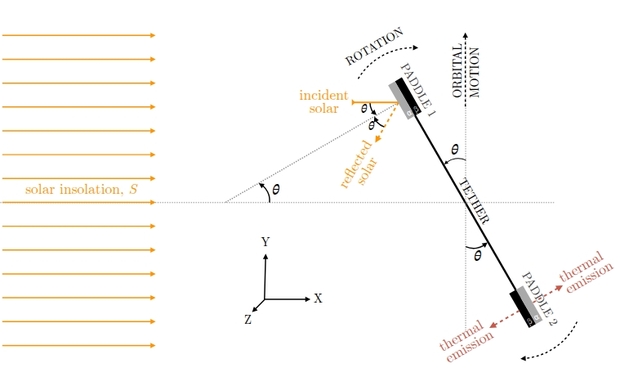
Image: This is Figure 1 from the paper. Caption: A simplified version of the TARS system. Here, the system comprises one tether and two paddles, which together are orbiting around the Sun, with an instantaneous velocity vector along the Y-axis. Incident solar radiation is largely reflected by the α-surface (the reflective surface) of the paddles, but largely absorbed by the β-surface. This leads to a radiation pressure torque that gradually spins up TARS. Note that both paddles experience both reflection and emission; we only show one of each for the sake of visual clarity in the above. Credit: Kipping & Lampo.
Below is an animation showing the basic concept, with the sails depicted here in the form of panels or paddles, with the same characteristics – a reflective side, a non-reflective side, and the two panels configured in such a way that the incident solar photons spin the system up. Now imagine a small payload at the end of one of these paddles being released just when the system has reached maximum spin-up, so that the craft, possibly the size of a small computer ship, hurtles away with enough force to achieve escape from the Solar System.

Image: This and the animations below are courtesy of David Kipping.
Spinning Up TARS
Don’t get wed to the idea of those sails as paddles; as we’ll see, other options emerge. The nod toward Breakthrough Starshot is evident in the choice of a payload built around microelectronics, but in this case we give up the laser array and use the power of the Sun rather than the collected energies of nuclear reactors to power up the craft. Also like Breakthrough Starshot, we can envision such tiny spacecraft being hurled in swarm formations so that they can network with each other during their journeys. After all, this is a remarkably economical system, capable of launching swarm missions to targets near and far.
So we’re talking about gathering rotational kinetic energy. As Kipping points out, even at 1 AU, Earth receives solar energy of 1.36 kilowatts per meter squared, so if we can tap that energy efficiently, we don’t need to beam our sail. The TARS concept gets around the inverse square law, the fact that solar photons push a sail outwards even as their efficiency plummets. Go twice as far from the Sun and solar energy is reduced not by two but four times. Whereas the spinning TARS stores energy in something analogous to a flywheel while remaining in its orbit. It then releases that energy in a single fling.
The question of TARS’ orbit is an interesting one. Kipping refers to the concept of a quasite, which he developed some years back, though only recently finding a use for it in this new idea. In an email this afternoon, he distinguishes his TARS orbit from the better known statite:
If we could engineer a sufficiently light (and reflective) sail, it is possible that the outward force caused by radiation pressure upon the sail precisely equals the inward gravitational force of the Sun. Such an object need not rely on orbits for stability, it could be placed wherever you want – hanging out in inertial space just motionless. A quasite is not quite so extreme as this. Yes it’s still a sail, but now the gravitational force exceeds the radiative force. Hence, it wants to fall into the Sun (but less so than a non-sail object).
To avoid TARS indeed migrating inwards, we give it a well-calculated nudge such that its tangential velocity is sufficient to keep a constant altitude from the Sun at all times. Although all conventional orbits do this too, the tangential velocity here is less than that of the Earth or indeed any other orbiting object. Hence it’s in what we’d call a sub-Keplerian orbit, and indeed dust particles can do this too since they too can feel strong radiative forces. This engineered quasite thus is a Solar sail which doesn’t recede (or migrate) from the Sun, it stays at the same separation which is crucial for TARS being able to build up angular momentum over time. A consequence of its slower tangential nudge is that it orbits the Sun slower than the Earth does (if at 1AU).
Shape and Material
TARS in its simplest form can be reduced to a single ribbon-like structure, where there is no tether, and the two paddles simply meet at the midpoint. The shape arrived at in the image below is optimum for ensuring rotational stability. The paper considers the use of carbon nanotube sheets, given that this material is more readily available in the market. Tapering the ribbon improves performance, with a segment at the end containing the payload, which can be reflective enough to gain an additional boost as it recedes from the Sun.
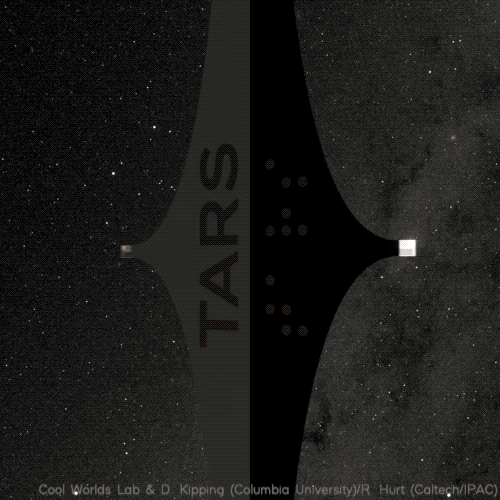
Image: For the purposes of calculation, Kipping works with a TARS that is seven meters wide and 63 meters long. The thickness is 2.8 microns, using carbon nanotube sheets, sprayed on one side with nanostructure silver and carbon deposition on the other. This thickness allows a microchip to be attached flush at the two ends, as per the illustration. This is light in weight (1.6 kilograms), so rideshare payloads are hardly a problem. As with solar sails, the device would have to be unfurled once it reaches space. Animation credit: David Kipping.
The calculations referred to above see a three-year spin up time and ejection of the payload at 12.1 kilometers per second – this limit is dependent on the tensile strength of the TARS nanotube sheets. Moving in its quasite orbit, TARS already has 28.3 kilometers per second. Kipping calculates in this configuration that the payload chip would leave TARS at 40.4 kilometers per second. This is just over Solar System escape velocity, making TARS an interstellar option. No beamed energy, no onboard propulsion, just solar energy collected and deployed.
So we have a payload roughly the size of a smartphone that can escape from the Solar System, but velocities can be increased depending on materials used – graphene creates a clear improvement, one that could be further tweaked with a gravity assist. An Oberth effect ‘sundiver’ maneuver is a possibility. And as Kipping notes, the payload can be reflective enough to serve as a small solar sail, acquiring additional velocity as it departs the inner Solar System.
A Magnetic Option to Boost Velocity
To go beyond these tweaks, applying an equal and opposite charge to each tip would create a rotating magnetic dipole. Out of this we get a magnetic field, which in turn yields electromagnetic radiation. A system like this, calculated in the paper, is capable of a critical speed in the range of 1000 kilometers per second. 0.3 percent of c. Meanwhile, the use of TARS to create magnetic shielding for uses in the Solar System can hardly be discounted. Kipping mentions in his video the prospects of using numerous TARS orbiters at Mars to provide radiation shielding for colonies on the surface.
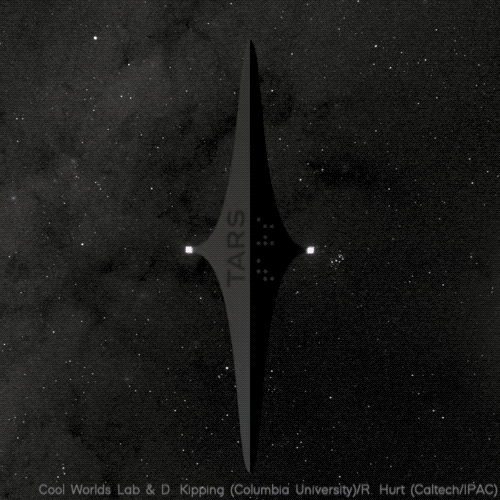
I sometimes hear from readers frustrated by the magnitude of the interstellar challenge. Even Breakthrough Starshot’s 20 percent of lightspeed takes too long for them, and they think we should put all our efforts into attempts to move faster than light. But progress is incremental in most cases, and whether or not we ever achieve breakthroughs like Alcubierre warp drive, we still push the envelope of what is practical today.
Progress is not just individual but civilizational. This is valuable near-term thinking that extends our capabilities one step at a time, and like TARS offers multiple uses within our System and beyond. One step at a time is the nature of the game, and these steps are taking us slowly but inexorably toward the sea.
The paper is Kipping & Lampo, “Torqued Accelerator using Radiation from the Sun (TARS) for Interstellar Payloads,” accepted at Journal of the British Interplanetary Society (preprint).


